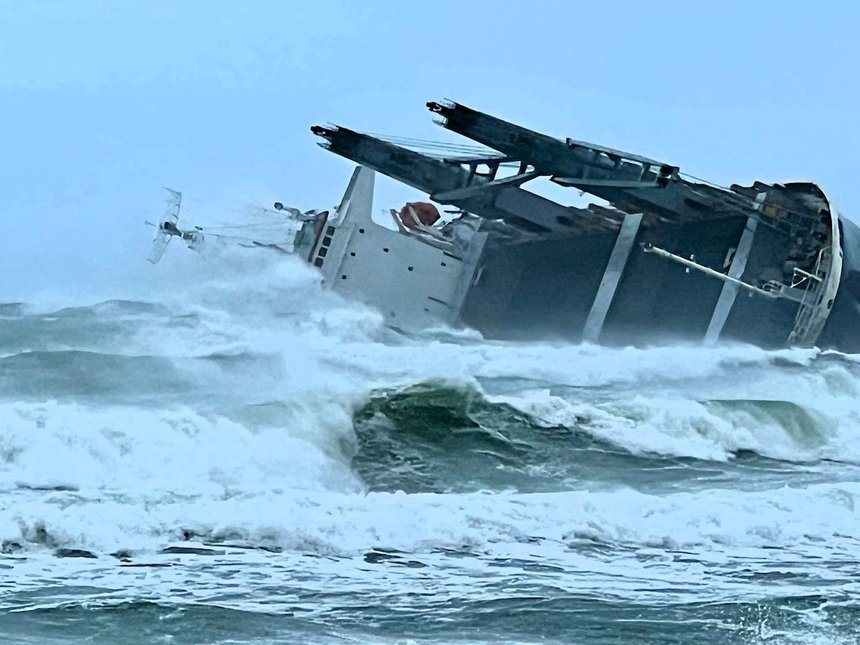The recent meteorological events at the southern tip of Africa, which blocked shipping for several days, confirm forecasts of an exceptionally intense hurricane season, such as Hurricane Beryl, which forced the closure of Texas ports. Here’s a look at the situation after three hectic days.
Freight rates were slowing down, and some analysts were already betting that the peak had been reached. But extreme and devastating weather events in South Africa could be heating them up again.
Cape Town and other parts of South Africa’s southwest coast are often hit by cold fronts during the winter months (mid-year), which bring heavy rain and strong winds. But it’s rare for several fronts to follow one another in a short space of time. This has been the case for the past week,
On land, the damage is considerable and the displacement of people massive, according to local authorities, who report impassable roads and rising waters.
The situation at sea has also taken its toll. The steep and dangerous waves off the South African coast, some as high as 10 m, coincided with a strong cyclone that hit the region as early as Sunday July 7, combined with temperatures well below normal.
Navigation blocked, operations suspended
CMA CGM announced that its 17,859 TEU Benjamin Franklin had lost 44 boxes and damaged a further 30 “as a result of severe weather conditions in south-east South Africa on Wednesday July 10”. Maersk warned its customers of possible delays due to rough sea conditions in the region.
Port operators announced that they had suspended loading and unloading operations in several ports, Port Elizabeth being the worst affected. South African port operator Transnet reported that several ships were also blocked at the Cape Town Container Terminal, and that those at Ngqura in Gqeberha had been closed.
In a note, the London Stock Exchange Group (LSEG) stated that no container ships had passed the Cape of Good Hope since July 8. This seems to be confirmed by vessel tracking data. “The situation adds to the congestion and delays exacerbated by the Red Sea crisis. We have a full stop at the Cape of Good Hope for container ships, both East and West. There has been no significant change in Red Sea traffic so far, but several container ships have turned back and/or are waiting off Durban,” says Fabrice Maille, Global Head of Shipping and Agriculture at LSEG.
Grounding and risk of oil spill
Conditions were so severe that the bulk carrier Ultra Galaxy, which had left the port of Walvis Bay in Namibia around July 4 and was heading for Dar es Salaam, had to be abandoned northwest of Cape Town on July 8, grounded in a remote coastal area after listing heavily. Its 18 crew members, all Filipino, were rescued in a lifeboat by a trawler, the South African Maritime Safety Authority reported on the X network.
The South African Maritime Safety Authority (SAMSA), which has reported several urgent salvage operations in recent days, said it had taken measures to avoid a major oil spill, noting that the vessel was carrying a cargo of bagged fertilizers, low-sulfur fuel and hydraulic oils.
600 container ships in transit
The situation arises at a time when the traditional route between Asia and Europe via the Suez Canal and the Bab-el-Mandeb Strait is prey to the exactions of the Houthis who, in support of the Palestinian Hamas at war with Israel since October 7, are waging another war there, this time against merchant shipping flying the flags of states that the faction originating from Yemen and armed by the Islamic Revolutionary Guards considers to be enemies.
These actions, carried out using drones and missiles in the Red Sea, have led to a mass exodus of much of the world’s fleet to the Cape of Good Hope, at the southern tip of Africa, adding 10 days or more to the transit time between Europe and Asia. This phenomenon has boosted freight rates, which are on the rise again, and generated congestion in some key ports where shipowners transship.
According to Flexport data shared on social networks, some 600 container ships are currently transiting Africa.
Freight rates stalled for the first time
While the temporary halt to shipments around southern Africa should not have disproportionate consequences, it will add a few days to already long transit times and risk exacerbating port congestion.
It could also cause freight rates to rise again. According to the latest Shanghai Containerized Freight Index (SFCI), which reflects transport prices from Shanghai to ports in some twenty destinations, freight rates marked the first pause in weeks, losing nearly 60 points in the week ending July 12. A temporary pause after several weeks of consecutive increases, including a 12.5% surge the previous week? Or just a breather before another round of the rollercoaster.
Source: Téma


